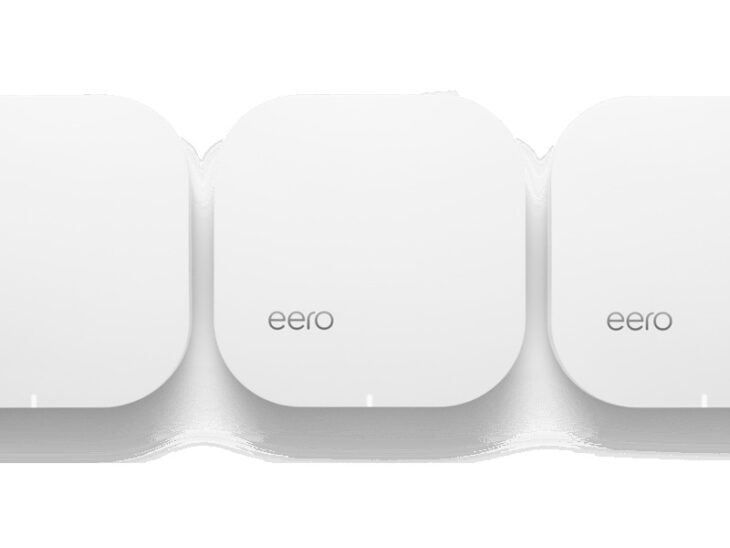Podcast: Play in new window | Embed
Laura in Wake Forest, NC listens on WPTF and asked:
“I have a problem with my Wi-Fi reaching all around my house and was wondering if one of those Wi-Fi boosters would help. And if so, which brand would be the best one?”
Wi-Fi boosters can work, but there are better options available now. You should look into wireless mesh access points.
There are a couple of systems you can buy right now. The eero system comes with one access point for $199 or three for $499. The magic happens when you buy the three pack.
You should look into wireless mesh access points.
Only one access point is connected to your network. The other two just get power connections. They all see each other and automatically work to boost your signal. The included software even helps you determine where in your home to place the remote units for the best possible coverage. These aren’t cheap, but they do seem to work by all accounts, and they will eliminate your dead spots.
Another similar product is the Ubiquiti UniFi Pro Enterprise Wi-Fi System. A three pack of them will set you back $585, but they’ve been around longer than the relatively new eero system has been, so they’ve been battle tested in a lot of different environments. They are, however, an enterprise level product.
Meaning that each of the three access points wants to have a data connection to your network, so the effort in installation goes up considerably. What they do, however, is seamlessly hand off devices in your home based on which access point has the best signal to that device. This means no more dropped connections and no more dead spots.
A company called Luma is coming out with a system to compete with the eero models, at only $250 for a three pack. That’s really nice pricing, IF they work as well as the eero devices do. They are not yet available, however, so if you want a solution today you’ll have to look elsewhere.
A company called Luma is coming out with a system to compete with the eero models
Wireless meshing including the hand-off of devices from one access point to another is the best solution for handling those dead zones. Unfortunately, it all comes at a price. Good luck!
We recently got a press release about the Athena-Ex (“ex” as in “extender”), we haven’t tested it ourselves, but it claims to extend your WiFi’s range up to 15,000 feet. It’s an impressive claim since WiFi connections are two way conversations and your WiFi devices have to have the power to talk back to the router or repeater device, but it’s something you may want to look into since it will cost you $219.
Eddie in West Pittston, Pennsylvania asked:
“Credit card smart chip tech. It’s not really new. It’s been around since the 80s. It’s the same technology that they used to hack Directv and Dish Network. The readers and writers are still available via the Internet. I’m looking for your opinion on how you feel it’s so much safer when the equipment is readily available to the public on the Internet to buy. Old technology. I hope it got better but in my opinion, I don’t feel it’s safe. They say it’s a digital fingerprint. It can be changed. Just looking for your opinion.”
You’re not wrong… the chips won’t make cards ultra secure, just a little more secure.
The chips you see in cards are known as EMV chips, which stands for Europay, Mastercard, and Visa, and they’re more secure than the magnetic strip, sure… since pretty much anything is frankly, but they’re not anything to write home about.
The US is actually the last country in the G20 to adopt EMV chips
The chips have been in use in Europe for a very, very long time, and the US is actually the last country in the G20 to adopt them, but the way they tend to work is by what’s called “chip and pin,” you slide the card in, it asks for a pin, if it matches what’s stored securely on the card the charge goes through. That’s the biggest advantage of the chip, better pin encryption via its EMV microcomputer. The thing is, in the US (at least so far) they’re being used as “chip and signature,” which means you slide the card in, sign, no one bothers to check the signature, and you move on.
It pretty much looks like the ones that really stand to benefit from the chips in the short term are credit card companies. The way their contracts are set up, if the card was read using the chip the fraud liability is on them, if it was swiped the business is liable.
Got an old strip-only reader? You’re liable. Got Square or PayPal? You’re liable.
Still, overall it is an improvement over the magnetic strip in terms of security, it’s just probably not one that’s worth the cost of replacing all the terminals at every point of sale in the country. They are still old technology, that if anything should’ve been adopted 10 years ago and should be in the process of being replaced now.
There is one big benefit to the consumer from using EMV chips, they can’t be easily skimmed like magstrips can be.
If you want a real and reasonable leap forward in security, try Apple Pay or Android Pay (with biometrics turned on), those two actually encrypt data properly and use biometrics to regulate who can use the card (just make sure you don’t enable an option to use “123456” or “mypassword” as alternative ways to authenticate, but hey… technology can’t cancel out stupidity).


